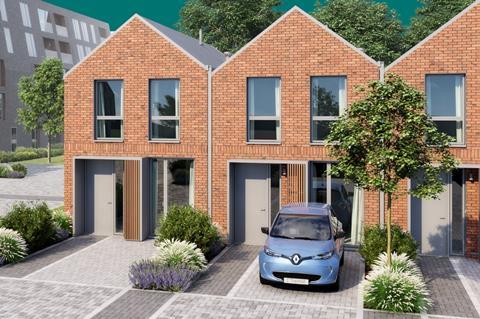The housebuilding sector is stuck in the past and should move towards a data-led manufacturing model inspired by the aviation industry, argues Matt Evans of Tophat
Fresh ideas are the lifeblood of progress. Meeting society’s needs – from more affordable housing for those most in need to creating sustainable frameworks for our planet’s future – requires us to challenge the status quo and apply fresh insight to familiar problems.

In a little over a century, carbon-fibre jumbo jets and commercial spacecraft evolved from rickety wood and canvas aeroplanes. In the aerospace industry, a focus on engineer-led technological innovation has continually thrust the sector forward. From materials to energy, the aerospace industry is constantly evolving with its sights set firmly forward.
A pilot from a century ago could hardly imagine, let alone fly, a modern aircraft. A bricklayer from the same period would feel right at home in a building site today
The housing industry, however, remains stuck in the past. A pilot from a century ago could hardly imagine, let alone fly, a modern aircraft. A bricklayer from the same period would feel right at home on a building site today.
As we know, the built environment contributes to 40% of the UK’s carbon emissions, and because of its over-reliance on concrete, contributes to 11% of CO2 emissions globally. In fact, if the concrete industry was a country, it would be the world’s third largest emitter.
And, in addition to building emissions, of course, we face an almost unfathomable retrofitting operation to reach a truly net zero UK housing stock. We won’t meet this challenge with traditional ways of thinking and building.
The aerospace industry has always been inherently innovative and disruptive, constantly redefining what is possible. If the construction industry is to hit net zero targets by 2035, then it must learn from aerospace and be willing to buck its own trends.

Airbus, the world’s leading aircraft manufacturer, has promised a zero-emissions hydrogen commercial aircraft by 2035. Disruptive innovations such as this are necessary for industries to remain sustainably focused.
Radical change in the housing sector has already begun. Modular housebuilders such as TopHat have jumped on innovations proven in aerospace to use digital-driven advanced manufacturing to build net zero houses at scale.
This data-led manufacturing model could revolutionise UK housing delivery, harnessing new technologies to improve design, assembly, and production. Unlike traditional housebuilders, modular innovators are weaving a digital thread throughout the housebuilding process for greater control in delivery and quality.
You would not manually build a plane in a field over months at the whims of the weather. In the same way, it makes no sense to build houses this way
With data captured at every step, these organisations drive a cycle of continuous improvement and ever-higher productivity. You would not manually build a plane in a field over months at the whims of the weather. In the same way, it makes no sense to build houses this way.
Aerospace has seen a revolution not only in how aircraft are built, but also in their core materials. Fuel efficiency and safety from material advancements have doubled every five years since 1987.
From heat-resistant and lightweight alloys to advanced composites containing nanoparticles and graphene for lightning strike protection, the industry is at the forefront of using materials to increase efficiency and sustainability.
Even incremental gains have a major impact on lifecycle sustainability. A single extra kilogramme on a passenger plane amounts to an additional £16,400 in fuel costs every year. Innovating to reduce energy usage and carbon production is both sustainable and financially prudent.
Similarly, TopHat’s use of low-impact timber in construction lightens the load on the environment by embodying 96% less carbon than traditional housebuilding materials. Precision engineering and factory control almost eliminates construction waste.
Imagine building three houses and getting the fourth one for free. Sustainable innovations like timber-frame modular homes emit 55% less carbon over a 60-year period – equivalent to living car-free for 30 years.
Technology-driven construction also allows real-time insights into energy-efficiency and utility diagnostics. Predictive maintenance systems, such as Airbus’ Skywise, have been a crucial component of recent aerospace technology. Applying these systems to construction allows for easier maintenance and early plumbing or electric fault diagnosis.
More than 1,000 data points are measured during the manufacture of a modular smart home; extending this technology over the life of the home could revolutionise post-construction net zero efforts
Although occupiers may worry about data misuse from these technologies, strict data protection laws mean that information can tailor home utility systems to save excess energy without compromising sensitive personal information. More than 1,000 data points are measured during the manufacture of a modular smart home; extending this technology over the life of the home could revolutionise post-construction net zero efforts.
Government incentives have undoubtedly catalysed aeronautical innovation. The UK government committed £84 million towards a “green aviation revolution” in 2021, hoping to attain zero-emission air travel by 2023.
Yet net zero modular homes are already attainable, so why not invest more in their delivery? The government has shown some faith in modular construction, but more must be done if construction is to foster green innovation at the same rate as aerospace, and housebuilders need to learn lessons from more technologically productive sectors.
Matt Evans is chief operating officer at TopHat and former vice-president, performance management and transformation at Airbus
























No comments yet